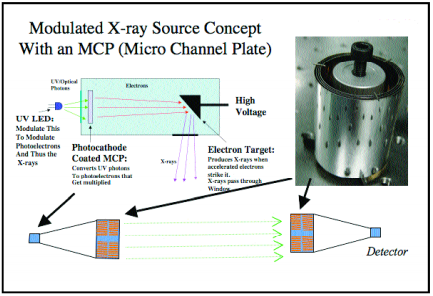Communication system is next 'giant leap for mankind'
As with most scientific advancements, a stroke of brilliant genius usually revolutionises status quo and opens doors for new discoveries. Something similar happened to Keith Gendreau, an astrophysicist at NASA’s Goddard Space Flight Centre in Maryland. NASA was thinking of using X-rays on its proposed Black Hole Imager.
Author: Rachel Oliver
Using a precisely-aligned spacecraft constellation, the Imager will collect X-rays emitted by the edges of supermassive black holes.
To enable the Imager to function perfectly, it is imperative that the constellation of spacecraft remains in position relative to one another. To achieve this, Gendreau suggested the use of X-ray emitters that will work as beacons to allow the spacecraft to remain within one micron of their intended relative positions.
Gendreau took this thought forward and suggested that these X-ray emitters could actually work as a communications system by using varying strengths of X-ray transmissions that can also be switched on and off several times per second. A unique signal can be created by these two parameters: varying frequency of the emitted X-rays and the on-off pattern.
This new kind of communication system based on X-rays, called XCOM, will be able to permit gigabytes-per-second data transmission throughout the solar system. To put this in perspective, the fastest WiFi currently (and theoretically) offers speed of up to 1 gigabit-per-second. As humans push the boundaries of space exploration, it is vital to stay in touch with Earth through a system that offers clear and fast communications across long distances.
XCOM offers numerous advantages over conventionally-used transmissions. Because X-rays have shorter wavelengths, they can transmit more data with less power than laser communication, for example. Hence, XCOM will also use less energy in communicating over vast distances.
The biggest advantage that XCOM has over other forms of communications is the ability to transcend obstacles that usually hinder radio communication. Whenever a spacecraft is entering the atmosphere, it generates an intensely hot plasma cover that blocks radio waves. This leads to ‘radio blackout’ during re-entry. But, high-energy X-rays can pass through this hot plasma, thereby keeping transmission intact during every phase of shuttle deployment, including atmosphere re-entry.
NASA has already devised an instrument called the Modulated X-ray Source, or MXS, to test XCOM under field conditions. MXS will generate rapid-fire X-ray pulses and will be deployed outside the International Space Station (ISS) in 2018. NASA has also tested the concept at their interferometry testbed at the Goddard Flight Centre. It is essentially a 600m long vacuum tube with an X-ray source at one end, with the detector being located at the far end.

MXS will be controlled by NavCube, a computing and navigational platform that combines two of NASA’s inventions – a reconfigurable, fast-flight computing platform called SpaceCube and the Navigator GPS flight receiver. NavCube has the ability to enhance performance even in space, where XCOM is expected to work.

While most of the technology is available, the development team is seeking additional funding to make the entire system space-ready. The trail run for XCOM is to be held aboard the ISS. The MXS will be installed on a pallet that will be placed outside the space station and will transmit data via X-rays to the receivers (56 X-ray telescopes) of the NICER (Neutron star Interior Composition Explorer) which will be 166ft away. MXS will be controlled by NavCube.
NavCube’s high-speed computing abilities along with the Navigator’s ability to track GPS signals will also be used for experiments on X-ray ranging, a technique to measure distance between two objects.
XCOM is really the proverbial ‘giant leap for mankind.’ It can not only transmit more data much faster over longer distances than any conventional method thus far, but can also be used as a guidance system for manned as well as un-manned probes in space. Celestial bodies, like pulsars, emit X-rays. A spacecraft’s navigational system can be tuned to respond to the specific pulsing of X-rays that is unique to it and these signals can help the spacecraft orient itself.
A project of such magnitude requires millions of electronic components. Some of these are ordinary, but the majority of them are rare or even custom-made for the project. With online sourcing partners like Digsemi, it has become easy to obtain even the rarest of electronic components for any kind of project. Even obsolete parts can be traced to one or the other stockist in the world.
XCOM is a brave new step towards discovering an unexplored world. It is the result of brilliance, conviction and impeccable use of available technology to create a system that will be vital to keep new-age space explorers in touch with Earth.


